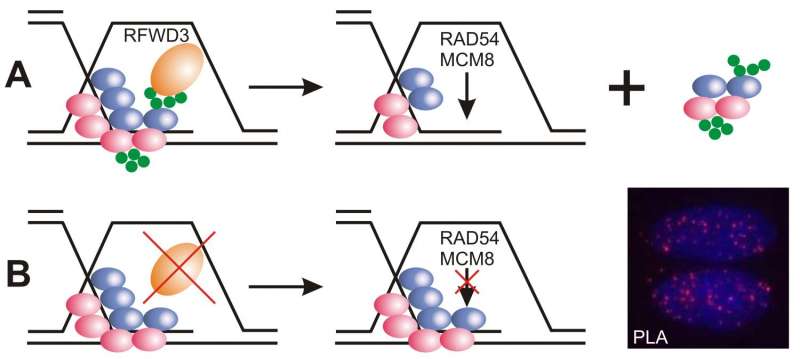Study identifies new gene mutation associated with defective DNA repair and Fanconi anemia

Fanconi anemia is a rare genetic disease characterized by hematologic symptoms that include low platelet count and unusually large red blood cells. Mutations in nearly 20 genes have been identified as causative for Fanconi anemia, all of which encode proteins involved in DNA repair mechanisms. The failure to repair DNA is also considered the source of increased cancer risk in individuals with Fanconi anemia. Ongoing efforts to identify additional genes and pathways linked to this disease may also reveal potential susceptibility genes for hereditary cancers.
This week in the JCI, a team led by Detlev Schindler at the University of Wurzburg describes classical Fanconi anemia-like symptoms in a 12 year-old individual without mutations in any known Fanconi anemia genes. Sequencing of this individual's genome detected missense mutations in both alleles of the gene RFWD3, which encodes an enzyme that helps target other proteins for degradation.
This patient's cells were more sensitive to chromosome breakage and showed other indicators of increased susceptibility to DNA damage compared to cells from healthy individuals. Cells lacking RFWD3 or harboring the patient's mutation showed similar DNA repair defects, which were rescued by expression of wild-type RFWD3. Moreover, RFWD3-deficient mice exhibited a phenotype that resembled other mouse models of Fanconi anemia. Together, these findings support the identification of RFWD3 as a Fanconi anemia gene.
Schindler and collaborators further describe the mechanisms by which RFWD3 mediates DNA repair in two recently-published studies in Molecular Cell. Future explorations of this enzyme may reveal its importance as a biomarker or therapeutic target in Fanconi anemia, cancer, or other human disease.
More information: Kerstin Knies et al, Biallelic mutations in the ubiquitin ligase RFWD3 cause Fanconi anemia, Journal of Clinical Investigation (2017). DOI: 10.1172/JCI92069
Laura Feeney et al, RPA-Mediated Recruitment of the E3 Ligase RFWD3 Is Vital for Interstrand Crosslink Repair and Human Health, Molecular Cell (2017). DOI: 10.1016/j.molcel.2017.04.021
Shojiro Inano et al. RFWD3-Mediated Ubiquitination Promotes Timely Removal of Both RPA and RAD51 from DNA Damage Sites to Facilitate Homologous Recombination, Molecular Cell (2017). DOI: 10.1016/j.molcel.2017.04.022

















